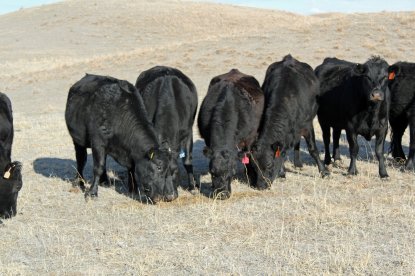
By Karla H. Jenkins, UNL Cow/Calf, Range Management Specialist and Aaron Berger, UNL Extension Educator
With limited winter precipitation and little to no residual standing forage from 2012, the effects of drought continue to plague area ranchers. When deciding how to handle limitations of feed resources, it is important to review the nutrient needs of the cow and her production cycle. A non-lactating cow in mid pregnancy has the lowest nutrient requirements of her production cycle. Once her calf is born her nutrient needs increase rapidly through peak lactation eight weeks after calving. In order to stay on a 365 day calving interval, the cow must rebreed less than three months after calving. Typically, producers are able to use high quality hay and/or lush spring forage to increase the nutrient density of the cow’s diet.
This year grass and hay are in short supply and may encourage ranchers to consider limit feeding cows in confinement or on a sacrifice pasture to stretch forage resources. Limit feeding is when cows are fed a diet containing ingredients that are energy and protein dense which meet the cow’s nutrient requirements but the cow is restricted in how much she eats. Energy and protein dense feeds can be fed with low quality forage to stretch limited forage supplies. Limit feeding in a drought situation can save feed costs because high energy and protein feeds can be fed with cheaper, lower quality feeds such as straw and crop residue and meet cow nutrient requirements. These rations are often cheaper to feed than purchasing hay that is equivalent in quality. These feeds can be critical for feeding with low quality forage to meeting the cow’s nutrient requirements after calving to ensure acceptable pregnancy rates during the breeding season. For assistance calculating cost per unit of protein or energy see the Feed Cost Calculator at http://westcentral.unl.edu/web/westcentral/agecon3.
Many cow-calf producers do not have access to hay grinders, feed trucks, or mixers. However, these producers can still utilize the principles of limit feeding and meet the nutrition needs of their cow herd.
For example, high quality alfalfa hay or supplement could be fed 2 or 3 times a week as a protein supplement as research has shown that to be as effective as feeding every day. This will help reduce waste and sorting of the lower quality hay of the base diet.
Producers who are feeding cattle without the benefit of bunks may want to feed under an electric fence. A fence strung high enough to allow cows to eat under prevents cows from defecating or bedding down on hay, reducing waste.
Limited bunk space could be utilized by dividing cows into two groups and feeding one group in the morning and one in the evening with a limit fed diet or with a high energy/protein supplement.
Utilization of an ionophore at recommended rates with limit feeding will improve feed efficiency.
It has been said that “necessity is the mother of invention.” People involved with production agriculture are some of the best at “making do” with what they have. With creativity, cow-calf producers without hay grinders, feed trucks or mixers can still utilize limit feeding as a way to stretch limited forage supplies. When considering or developing a limit fed ration, consult with UNL Extension Educators and Specialists who can help with ration balancing.
For more UNL Beef information go to http://beef.unl.edu